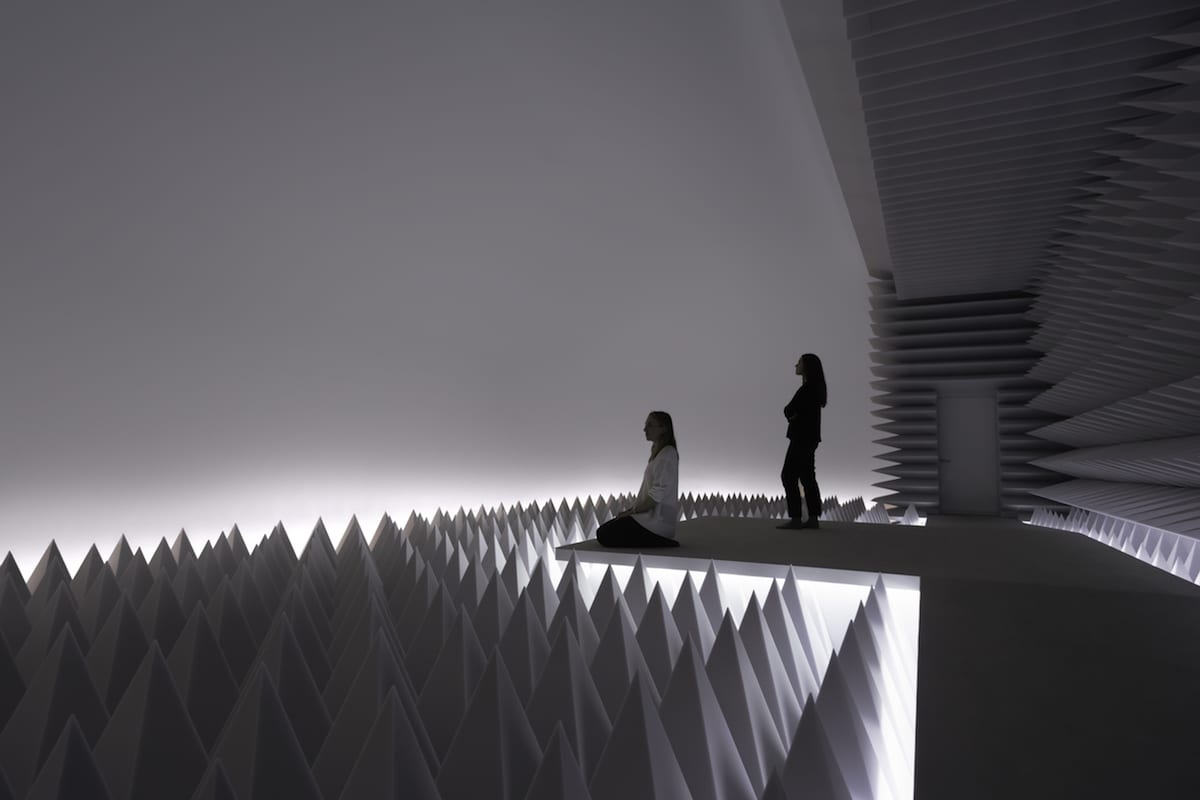Modernity did not come quietly; it arrived on the back of sirens, artillery fire, taxi horns, and turbine roars. Though industrialists and engineers of the last two centuries can claim no proper patent on noise, certain entrenched accounts credit factory floors and steam trains with the final mortal wresting of groans, bangs, and booms from the mythological mouths of gods and volcanoes. In 1913, Italian Futurist Luigi Russolo famously linked noise’s de facto birth to the nineteenth century and its “invention of machinery,” and the novelty of the Industrial Revolution’s relentless grind is registered throughout personal and literary accounts of its contemporaries.1
While Russolo wrote reverently of such noise, more conflicted descriptions of a vanishing quietude have populated narratives of modernization for centuries.2 It is perhaps most memorably in Henry David Thoreau’s Walden (1854) that the “whistle of the locomotive” comes to compromise the rich silence of the New England woods, announcing, with its hawklike “screams,” a new threat to bucolic solitude.3 “Here come your groceries, country. . . . And here’s your pay for them,” Thoreau declares, making explicit the Faustian bargain of which silence was one casualty.4 Silence, for Thoreau, was not an empty space in waiting, but a powerful haven of “depth and fertility,” presence and presentness—and at the time of Walden’s writing, it was already showing its cracks.5
It is of course a profound irony that modern technology has just as powerfully pursued silence and silencing since Thoreau’s time, elaborately recouping and retrofitting the calm it has come to drown out. At the turn of the twentieth century, cities responded in kind to the noise of industrialization with abatement campaigns, legal codes, and the emerging business of “sound control,” which throughout the following decades lined schools, offices, and concert halls with insulating plasters and thick-padded fiber.6 Driven by corporate and technoscientific desires for instrumental clarity—“efficiency” of communication—these developments engendered a kind of quiet synonymous with sterility and absence.7 In the face of its own noise, modernity brokered silence’s return as technological prosthetic.
●
In March 2017, an intimate installation by artist Doug Wheeler brought the tools of modern sound suppression into contact with a different conception of silence: something more like the deep and fertile quietude mourned by Thoreau. Titled PSAD Synthetic Desert III, in partial reference to the expansive landscape of the southwest, Wheeler’s work ported preternatural quiet into New York City’s Guggenheim Museum, offering visitors timed stays in a space constructed with sound-absorbent foam and soft, diffuse light. Wheeler first conceived of Synthetic Desert decades prior to the Guggenheim exhibition, committing a diagrammatic drawing to paper in 1971. Like many of Wheeler’s spatial environments, the piece demanded a high degree of technological and financial investment, and it was not until its engagement by a Guggenheim research and preservation initiative that it found the resources it needed to take shape—with certain compelling augmentations.8
Wheeler expressed hope that Synthetic Desert’s echoless quiet and diffuse, enveloping neon light would inspire “elating” feelings of “expanse and distance,” and indeed, like many of Wheeler’s works, the installation has been celebrated for its phantasmic play with perception.9 If these effects operate viscerally, however, anterior to words, deeper generative tensions nest in the installation’s technological makeup, inviting address at a critical remove.
Here, I revisit Synthetic Desert one year after its August 2017 deinstallation with an attention to its employment of anechoic technology: technology originally designed to drive reverberant sound toward its vanishing point and effect a sterilizing silence optimal for scientific—and, notably, militaristic—operations. If its material understructure roots it in an uncomfortable lineage, Wheeler’s work accepts the anechoic as grounds for a critical remediation. Synthetic Desert occasions an exploration into the divergent traditions that have attached themselves to silence in search of innovation, destruction, and emancipation; most revelatory, it occasions a stirring convergence of these legacies, tempering notions of silence premised on absence with the elevation of a new kind of presence.
Anechoic Histories
Born in 1939 in Globe, Arizona, in view of the state’s rangy mountains and arid stretches of the Sonoran desert, Doug Wheeler was raised by parents skilled in general aviation. A doctor, his father would fly to administer surgery to faraway patients, and Wheeler would often accompany him; he would later acquire a pilot license of his own.10 From the seat of a biplane, and in the light of a lowering sun, the mountains of Arizona’s high desert must have looked quite like the red pyramids dotting the bottom of Wheeler’s 1971 drawing for Synthetic Desert.11
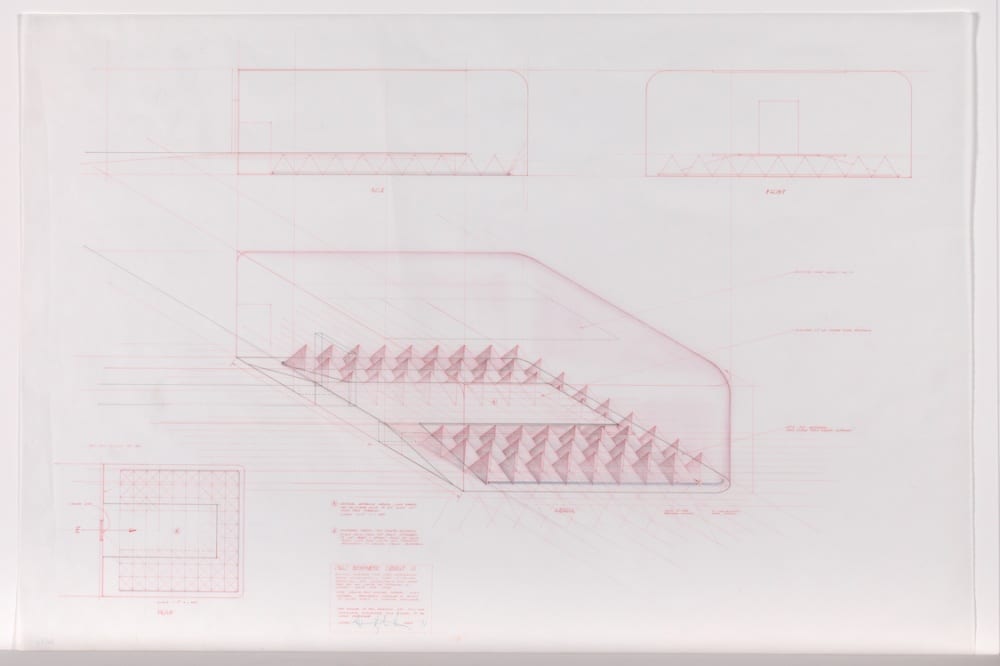
A blueprint for an installation in potentia, as well as a certificate of rightful ownership, this drawing describes a space of perceptual play and expansion in relative continuity with the artist’s previous work. A graduate of Chouinard Art Institute in Los Angeles (now the California Institute of the Arts, or CalArts), Wheeler is most canonically associated with the Los Angeles-centric Light and Space movement, owing to his perennial interest in sensory limits and lines of expansion. Among his immediate peers were such figures as James Turrell, Robert Irwin, Maria Nordman, and Larry Bell.12 The mid-to-late sixties marked an evolution in Wheeler’s practice, witnessing his move from all-white abstract painting to a dissolution of the canvas altogether; in his “fabricated works” and “light encasements” exhibited in 1968 and ’69, Wheeler used panels of lacquered Plexiglas and then vacuum-formed acrylic—haloed with the glow of neon tubing—to effect a bottoming-out of framed space, now given over to the viewer’s imaginative faculties.13
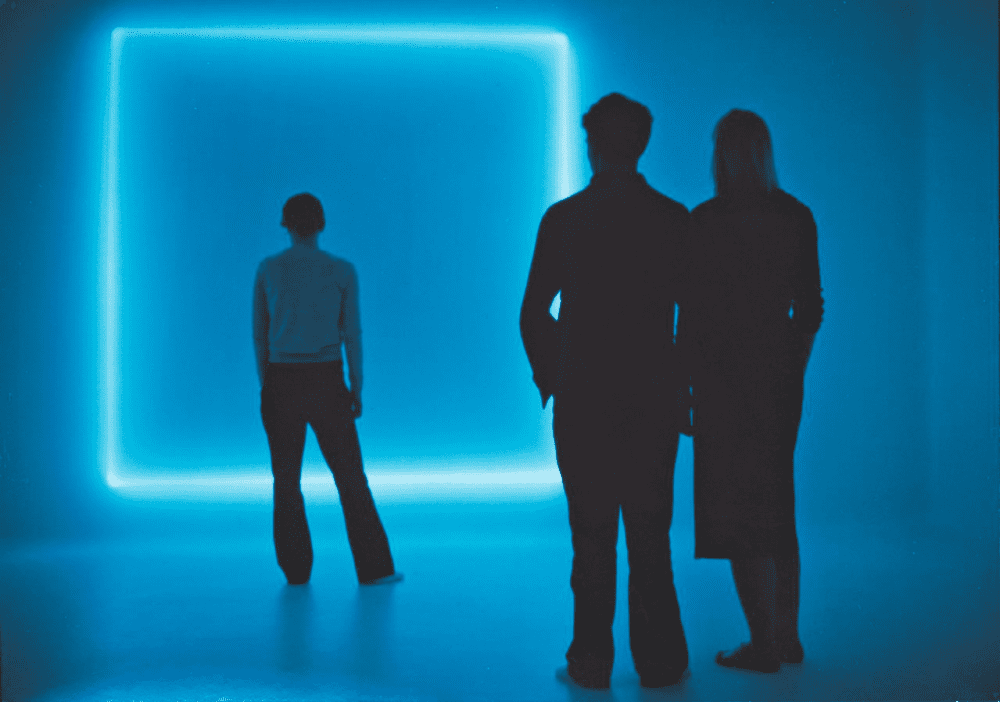
Wheeler soon introduced a series of room-scale installations predicated on ganzfelds: “total fields” of diffuse light and featureless white.14 An early iteration appeared at Amsterdam’s Stedelijk Museum in 1969.15 These spaces worked to unmoor viewers from architectural space and more intensely figure light itself—intangible yet encompassing—as a material with a fugitive presence.16 As a contribution to a May 1970 Tate Gallery show, Wheeler constructed an elaborate light environment with the ample aid of a curved fifty-foot wall; artists Larry Bell and Robert Irwin rounded out the exhibition’s triple bill with environments of their own.17
Comprising an inclined floor canted toward a luminous and, significantly, sound-dampened void, the Tate installation experimented further with the making sculptural of space, promising yet more avenues of exploration with its integration of physical components “in addition to light.”18 In the biographical overview of Wheeler in the exhibition’s catalogue, curator Michael Compton suggestively wrote that Wheeler “has been working on a project which involves the elimination of the physical wall and its apparent replacement by a screen of intense light through which a person could pass and vanish, and on the creation of virtual values by acoustic means.”19
As Compton suggests, Wheeler was at this time undertaking a pointed exploration of the sonic in tandem with the optical, and the 1971 drawing for Synthetic Desert is evidence of this line of inquiry.20 While the environment depicted in the drawing incorporates elements then common in the artist’s practice—white ultraviolet neon, spatial envelopment, and a delimited walkway—a change is signaled by the presence of the acoustic foam tiles (telltale “sound control” tools). Not exclusively a space constructed for visual presentation, Synthetic Desert was, from first conception, a space acutely concerned with sound—most notably, its conspicuous lack. The inscription on Wheeler’s drawing labels it an “anechoic chamber”: that is, a chamber optimized, through the meticulous application of absorbent material, for the elimination of echo—the reflective residue of sound events so easily cast off by glass, steel, and concrete. Effective “silence” follows.
Wheeler’s drawing, in its exacting technical precision, remains an important reference, and it will prove particularly instructive to examine it in view of its 2017 realization at the Guggenheim Museum. Excepting, for instance, apparent alterations to the ramp structure and the distribution of the foam pyramids (ultimately more dense and numerous), the drawing closely predicts the installation as realized. The structural fundamentals—the illuminated cavity, and the absorption-treated platform, walls, and overhang—are concretely present, agents of seamless time travel.
The material and conceptual principles of Wheeler’s installation are all of interest here, but one aspect of its design invites scrutiny: as will be explored, Synthetic Desert’s 2017 realization set itself squarely apart from the anechoic chamber as such, employing anechoic foam to great phenomenological effect, but doing so in concert with an newly introduced sound element that subtly constellates beneath the perceived near-silence. In a 2017 interview, the artist expressed wariness of the true, “supersilent” anechoic chamber’s tendency to make people “batty” or force endurance on the part of its occupants, and while Synthetic Desert’s 1971 drawing invokes the anechoic by way of technical shorthand, Wheeler was, from the outset, conceiving of a space far different than the anechoic chambers developed in the preceding decades.
While the practice of soundproofing has a longer legacy in experimental science, where it reaches back to the nineteenth century, the historically unique creation of the anechoic chamber evolved with astonishing rapidity over the course of the early-to-mid twentieth century.21 The otherworldly quiet of anechoic space indulged a desire on the part of engineers and physiologists for an environment in which the precise nature and consequences of acoustic phenomena could be analyzed apart from the extraneous noise of the outside world. The sonic profiles of machines and their constituent parts could be studied and calibrated with expert precision, just as tests concerning human responses to sound could be carried out in a controlled experimental environment. As will be seen, it was in American military research that these differing purposes coalesced in a most urgent way, feeding the accelerated development of weapons and defense systems during World War II.
Today, nearly a century on, the anechoic chamber has effectively been perfected as a physical fact. It was only three years ago that Microsoft trumped a decibel record held by Minneapolis’s Orfield Laboratories (-13 dB) with a chamber measuring -20.6 dB—that is, twenty decibels beneath the threshold of human hearing (and one hundred beneath the typical loudness of a city street).22 Synthetic Desert hovers closer to 10 dB.23 The chambers developed in the mid-twentieth century were hardly so structurally and materially refined, but their development was eagerly facilitated—the product of exhaustive research and tremendous monetary investment.
Though the reconstruction of the chamber’s precise genesis proves a surprisingly difficult task, there is general agreement that the first proper room was constructed by E. H. Bedell of Bell Labs, who in 1936 achieved an impressive degree of absorption with eighteen and a half inches of layered muslin. The effort was nothing if not commendably crafty—material was packed firm against walls and held in place with wire netting—but the damping faltered in the low-frequency range.24 A breakthrough for anechoic construction arrived in 1946 when Leo L. Beranek and Harvey P. Sleeper published a paper detailing their exhaustive research concerning structural approaches to absorption.25
The paper grew out of the pair’s “war work” at Harvard University, where they were able to draw on the generous funds of the National Defense Research Committee; a reported $350,000 was allocated for the roughly fifty-square-foot concrete bunker whose foam wedges represented “seven railway carloads” of fiberglass.26
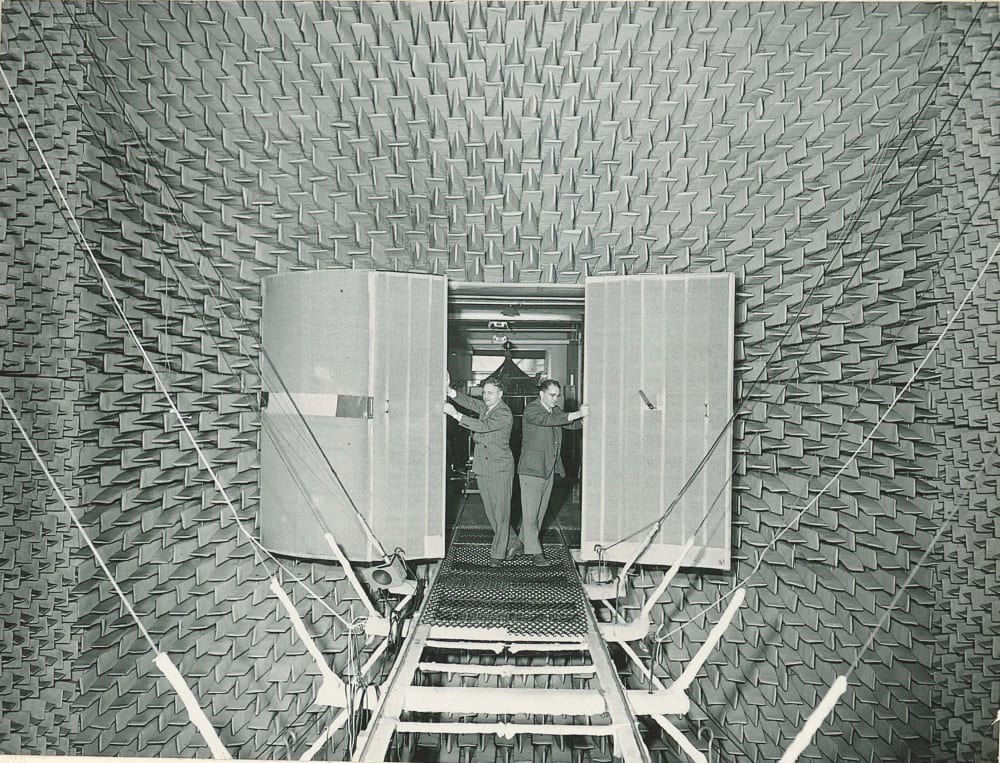
The chamber, nicknamed “Beranek’s Box,” was eagerly exploited by military interests, with ground forces initially hoping to test loudspeakers developed for beach landings.27 The intense sound levels of these speakers—used either to broadcast instructions to troops or, quite fantastically, to simulate tank and truck noises in deceptive maneuvers—precluded their testing outdoors in inhabited areas. Beranek’s chamber offered the minimal reflectivity of the outdoor environment along with a critical element of secrecy.28
A 1949 film produced by the United States Department of War—ripped to YouTube—investigates the “ghost army” that carried out the “sonic deception” to which Beranek was party. An index of US Army motion pictures and film strips reveals that this 29-minute film was designated “11-1151 Sonic Deception (U)” and indeed—as its title slide indicates—classified “confidential.”
Beranek’s Box is emblematic, for the subsequent perfection of rooms such as these was carried out largely under military auspices. Bankrolled by groups like DARPA (Defense Research Project Agency), research programs labored throughout the following decades to test everything from Vietnam-era helicopter rotors to airborne radar equipment.29 As Beranek notes in his memoir, the economic resources available during World War II were effectively bottomless. He recalls that a fund listed in the Harvard Bursar’s office as “LLB—Anonymous Research” contained the modern-day equivalent of forty million dollars, and remarks that this reserve was simply “one illustration of the vast resources that our country was channeling into military programs at [that] time.”30 Held aloft by the accumulation of military-industrial capital, Beranek’s research was part and parcel of a wartime initiative that, per science writer Gerard Piel, fashioned universities into “vast weapons development laboratories.”31
The evolution of the anechoic chamber pulled not toward the manufacture of a neutral silence, but rather toward what I would term a technosilence, or a silence whose threshold was dictated by the demands of technological experimentation. Distinguished by an instrumental—as opposed to inherent—value, technosilence took the optimization of military devices as its matrix of reference: rooms were widened to accommodate whole planes; foam wedges were lined with electromagnetic shielding to allow for the testing of weapons platforms and radar.32 The fundamental condition of technosilence, which awaited the focused articulation of mechanical tools, was absence of “interference”—in other words, any and all signals not “deliberately generated.”33 In early anechoic environments such as Beranek’s, the only sanctioned acts of communication were the rumbles, hums, and whines that prophesied invention—and war.
In its rigorous pursuit of sonic purity, and thus its expulsion of foreign noise, the anechoic chamber closely predicted the similarly austere space of the “clean room” (or, optimally, toxin-free laboratory), that fittingly arrived, in the early Cold War era, alongside a new professional discourse of containment and “contamination control.”34 So too can technosilence be tethered to what Caroline A. Jones has described as a midcentury drive, within modernist aesthetics, toward the segmentation of the senses and a consolidation of the ocular.35 The modernist sensorium, emblematized by the aggressively “optical” program of formalist critic Clement Greenberg, was fastidiously deodorized and noiseless.36 This doctrine dovetailed neatly with the “aesthetic of efficiency” proffered by the business of sound dampening and acoustical insulation.37
Accessioning technoscientific and arch-modernist traditions through its adoption of the anechoic, Synthetic Desert locates itself within freighted historical territory and poses a pointed set of questions: how to reconcile martial histories with more modestly humane aims? How to replace sterile technosilence with silence of “depth and fertility”? For answers, one might look elsewhere in the annals of art history, for midcentury purification practices hardly had exclusive claim to quiet.
While the phenomenological experience of anechoic silence cannot easily be “illustrated,” the above recordings, when compared, adequately demonstrate the “unnatural” quality that sound takes on in anechoic space. In Sample A, Mozart’s “Eine Kleine Nachtmusik” (1787) is performed in an anechoic environment. In Sample B, artificial reverb has been applied to the anechoic recording. Whereas A sounds anemic and astringent, and is apt to elicit a slight unease, B, with its simulation of standard levels of indoor reverberation, sounds relatively “normal.” I thank Beat Kaufmann of Createc for these mixes.
Recuperating Silence
The work of Wheeler’s attributed Light and Space cohort variously complicated and negated the segmented sensorium and formalist demarcation native to modernism.38 In a 1976 interview broadly revealing of Light and Space ideals, Robert Irwin voices to Frederick S. Wight his interest in “expanding the idea of perception itself” and undoing the tidy, “literate” conception of the senses that had come to nest in so much midcentury art.39 Perception, to Irwin and his peers, was a black box to be pried open and pored over, and if high technology could prove useful in this endeavor, then so much the better.
In 1968, as Wheeler was developing what would become Synthetic Desert, Irwin and James Turrell were invited to participate in Los Angeles County Museum of Art (LACMA) curator Maurice Tuchman’s contentious Art and Technology initiative (1967–71), which paired artists with local technology giants.40 Irwin and Turrell were contracted to work with the Garrett Corporation aerospace company, and there met NASA scientist Dr. Edward Wortz, who was then aiding in the development of life-support systems for lunar travel; the trio initiated a series of perception-oriented experiments and soon found themselves keenly interested in the anechoic chamber at UCLA. Irwin’s evocative account of anechoic silence indeed closely recalls Wheeler’s language: “For a few hours after you came out . . . you really did become more energy conscious . . . everything has a kind of aura.”41
Ultimately, the group’s proposed project, which would have exposed visitors to the anechoic chamber as well as a Plexiglas ganzfeld sphere, was curtailed after Turrell left the project in 1969.42 The trio’s flirtation with the anechoic remains an oft-cited historical curiosity; Turrell and Irwin, however, were not the first art-world figures to consider anechoic space. Technosilence had, decades earlier, come under a more philosophical scrutiny when composer John Cage paid a visit to a Harvard anechoic chamber in 1951 or 1952. Owing to discrepancies in Cage’s own accounts, there is some confusion as to when the visit occurred; so, too, is there debate over whether Cage visited Beranek and Sleeper’s chamber, or the anechoic room in Harvard’s Memorial Hall—the latter used for psychoacoustic research.43
If Beranek’s own verbal account is to be believed, it was indeed in his chamber that Cage heard all the world’s din reduced to only two sounds: one high, one low. An engineer later identified them, respectively, as the sounds of the nervous system and the circulatory system.44 Here, Cage came to understand that “silence” is simply the name we apply to that substrate of ever-present noise not yet intended, shaped, or penetrated by increasingly sensitive recording technology; in the years following, both his infamous “silent” composition 4’33” (1952) and his later sixties work fixated on the amplification of “small sounds” (e.g. Variations VII, 1966) bore the mark of this experience.
Captured here is Cage’s performance of the composition Variations VII at the 1966 festival “9 Evenings: Theatre and Engineering,” which paired leading avant-garde artists with practicing engineers in a bid for peacemaking between the arts and the sciences. Variations VII used a variety of electronic devices and appliances—transistor radios, telephone lines, Geiger counters, and electrodes—to intercept and draw together a complex patchwork of waves and signals normally hidden from audibility, whether for their “smallness” or means of transmission.
Against the grain of technosilence, which relied on a hermetic suppression of (unintended) sonic activity, Cage had, in Douglas Kahn’s keen estimation, “filled music up”: discovered presence in seeming absence.45
It would seem that Synthetic Desert, as ultimately realized, took Cage’s revelation as axiomatic, for the possibility of “true” silence was to be fundamentally subverted by a critical new inclusion in the installation: the incorporation of near-imperceptible ambient sounds, first described on a contemporary blueprint titled Synthetic Desert Sound Map (dated February 2017).
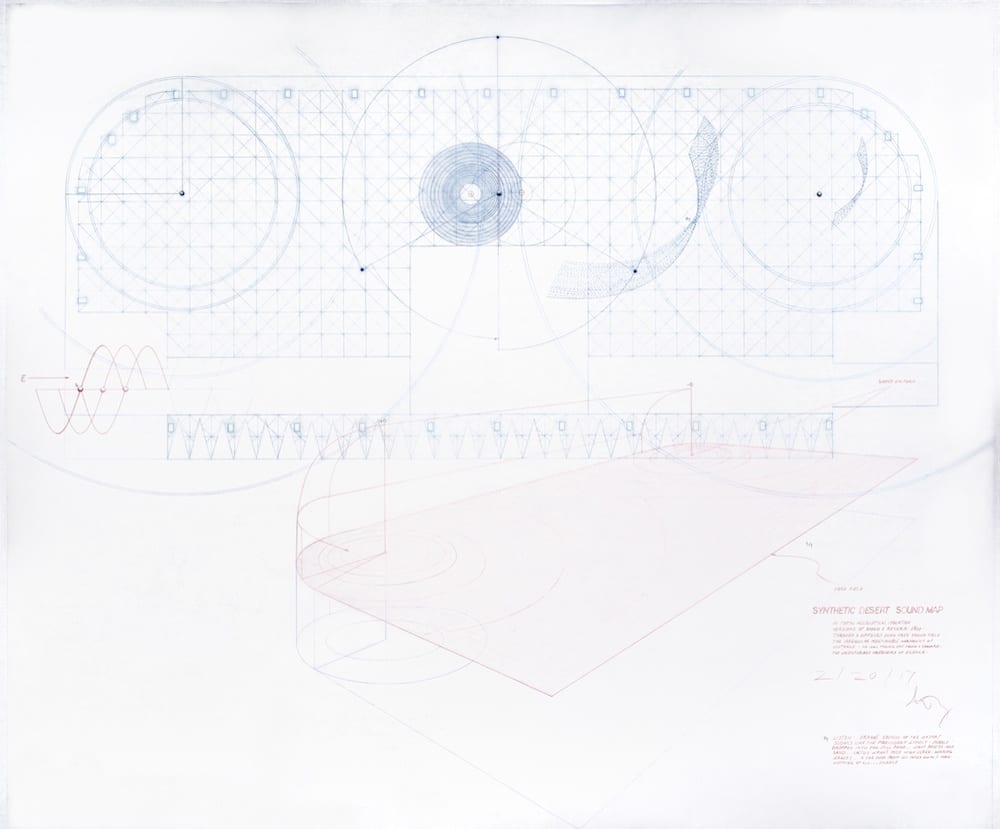
The Sound Map—with its significant addition of directional sound emitters, carefully marked out alongside the project propagation of the sounds themselves—marks an evolution of Synthetic Desert’s design as originally schematized. As he proposed complications to Synthetic Desert’s anechoic integrity with the Sound Map, Wheeler conceived of his project in newly poetic—and polemical—terms, straying ever further from technosilence and its expulsion of the outside.
A textual inscription in the corner of the Sound Map, rendered in minute capital letters, describes Synthetic Desert’s sonic additions thus:
LISTEN – ERRANT SOUNDS OF THE DESERT
SLOWLY LIKE THE PRECIDENT EFFECT – PEBBLE
DROPPED INTO THE STILL POND. . .LIGHT BREEZE OVER
SAND. . .CACTUS WREN? MILE HIGH SCREE – SOARING
EAGLE?. . .A CAR DOOR FROM 100 MILES AWAY? THEN
NOTHING AT ALL. . .SILENCE.
Unfolding “errantly,” according to the aleatory script of the natural world, these sounds operate on the very obverse of the anechoic chamber’s rigid mesh of “deliberate” signals. They are also powerfully personal—sure to have been encountered firsthand by Wheeler in the flat expanse of the Mojave desert. Wheeler’s words open onto a desert marked not by deprivation, but rather by an ecstatic play of threshold activity. The injunction to “listen” looms as the inscription tracks the slow passing of sounds into “silence.
●
For decades, Synthetic Desert’s quiet remained only notional, confined to paper. Its road to fruition began with the project’s September 1975 sale to the Italian collector Count Giuseppe Panza di Biumo; the drawing was among fourteen works by Wheeler that the late Panza, a foundational collector of postwar American Conceptual and Minimalist art, later transferred to the Guggenheim Museum as part of a 1991–92 bequest.46 It was realized in spring 2017, a near half-century later, through the efforts of the Guggenheim’s Panza Collection Initiative—a research and preservation project most recently engaged with the work of Wheeler and Irwin.47 Realized over two years by conservator Francesca Esmay, senior curator Jeffery Weiss, and Melanie Taylor, director of exhibition design, Synthetic Desert was unveiled in the Guggenheim’s seventh-floor tower, where it sat suspended on gaskets at the end of two hallways-cum-“sound-locks.” Set apart from the museum’s broader structural vibrations (and, by extension, the echoes of its cavernous lobby), the room was built to hover at an otherworldly remove.48
Cushioning one’s very steps into the installation, insulating foam fully lines the portion of the space accessible on foot.
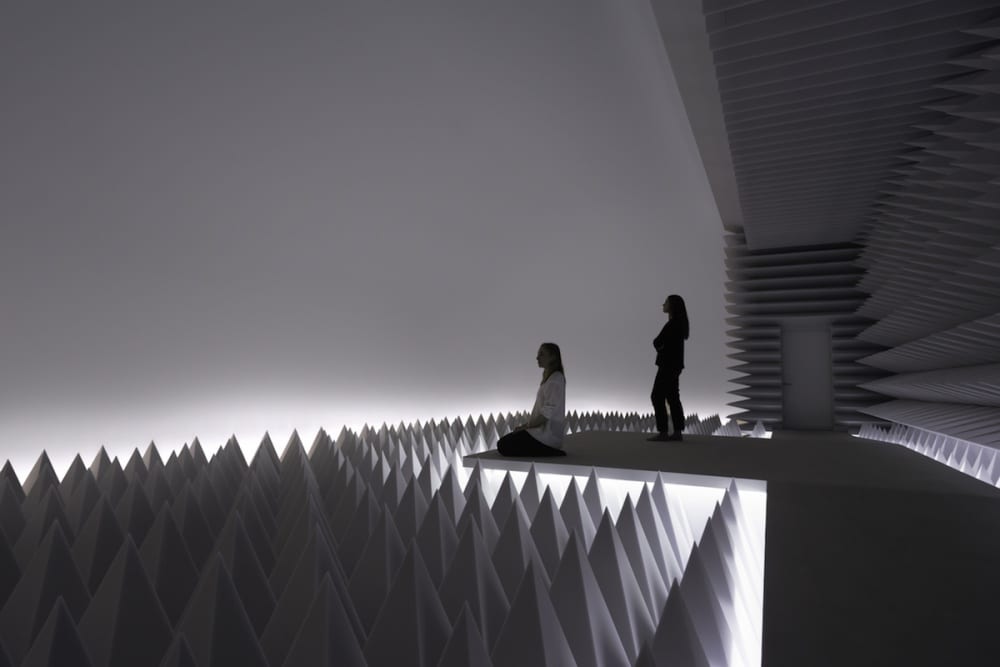
Opposite the walkway, Synthetic Desert sheds its pyramidal absorbers, which bleed beyond the protruding platform only on the floor below; the space gives way to a muted expanse of white ultraviolet illumination, whose precise contours hide from visibility. So constructed, the environment is, once again, semi-anechoic—but powerfully quiet nonetheless. Wheeler himself recently admitted, “I’ve almost never experienced real silence—it’s just certain degrees of quietude.”49
The hushed emissions of Synthetic Desert’s directional speakers, cleverly concealed amidst the hollowed-out cavities of select foam absorbers, aided powerfully in the negotiation of the delicate and mobile boundary separating silence from “quietude”; in the course of the installation’s design, field recordings were sourced, analyzed, and held against anechoic benchmarks in pursuit the acoustic profile—and thus perceptual potency—precisely desired.50 It is the ambiguity of said boundary, of course, that proves a generative engine for Synthetic Desert’s allure. In tandem with the environment’s ganzfeld, which brings an ethereal glow and sense of infinite boundaries into a space so known for darkness, the installation’s extraneous sound, in opposition to sensory deprivation, offers a more dynamic and delicate play with perception. Miming Wheeler’s written invitation to “listen,” outside ambience dances at the edge of audibility, courting a sensitizing of attention while enacting a symbolic un-walling—an opening out. Synthetic Desert is registered not as a hermetic test environment, but rather as a generative field for new forms of intimacy and presence: of space, air, and quietude.
And self-presence, too; one may well “come to [their] senses” in Synthetic Desert, as Cage in his anechoic chamber.51 They may hear their blood, feel their body’s contours—or they may simply hear a biplane soaring overhead. Typically accosted and strained by the clamor of lived space, attention is here freed up and given over to a newfound mobility and inner fullness. Brought to bear is the full weight of Wheeler’s firm belief that “voids have matter,” his language closely recalling Cage’s assertion that there is “no such thing as an empty space or an empty time.”52
Free Field
One obscure phrase on Wheeler’s 2017 Sound Map, tethered by an arrow to a faint red grid toward the bottom of the drawing, brings a wealth of insight to this discussion of the void: “free field.” In the parlance of acoustics, a free field is said to exist if an acoustic field permits the indefinite and unhindered propagation of sound waves, free, in such situations, from any surfaces that might cause reflections. The free field is the figure of sound “[radiating] into an infinite medium, unbounded by any barriers.”53
It is a fantastic irony that free-field conditions only exist, for practical purposes, in two spaces of diametrical opposition: the wide expanse of outdoor environs, and the close confines of the anechoic chamber. Reads one technical description: “This natural hearing condition in an ideal open environment (say, the desert) is approximated in the laboratory by covering all walls and reflecting objects in the experimental room by high quality–sound absorbing foam wedges.”54 But the “synthetic” free field was not always the province of the indoor chamber; before Bedell and Beranek’s innovations, acousticians more crudely approximated free-field conditions in the open air. A 1934 paper on sound-localization techniques finds researchers Stanley Smith Stevens and E.B. Newman mounting a tall swivel chair placed high on the roof of Harvard’s Biological Laboratories in order to conduct experiments free from reflection.55
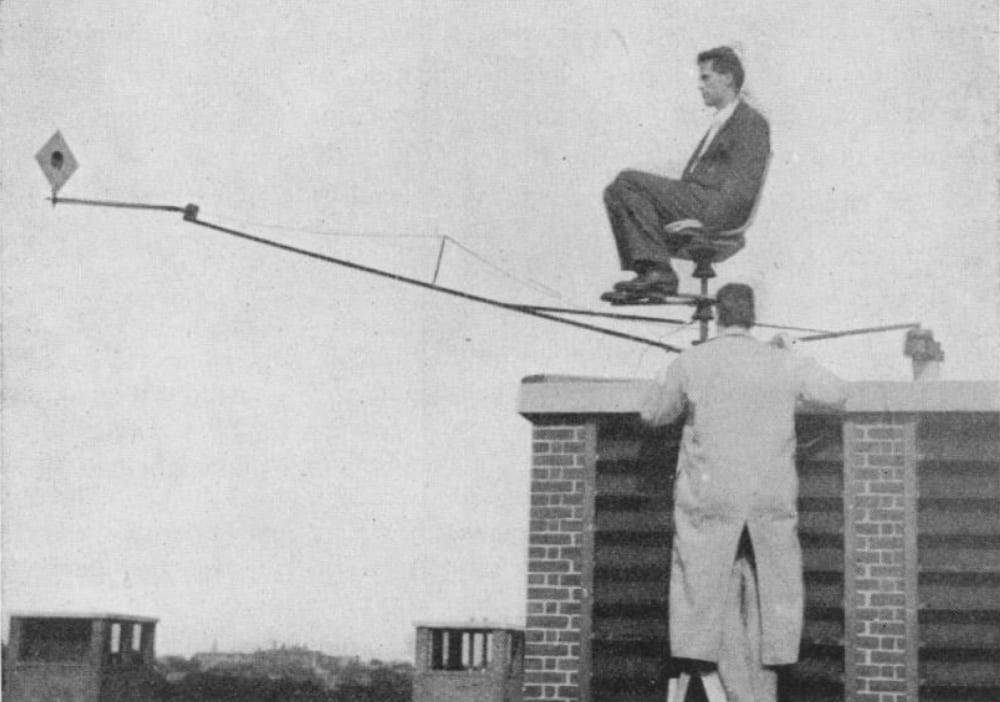
Wheeler’s Synthetic Desert offers a slight return to this open-air history, suspending itself between two poles: the “synthetic” space of the chamber, and the true free field of the desert. Drawing outside field recordings and an artificial twilight into its interior, the installation demonstrates the paradox underlying the equation of deprivation and distance, the artificial and the natural, undercutting its technological imperative and complicating its purely functional usability as an anechoic chamber. Synthetic Desert complexly hyphenates anechoic histories, holding them in view even as it pulls towards a calmer elsewhere; its response to the roar of rotors and military loudspeakers is not total erasure, but rather reclaiming and recuperation.
A certain unease does remain. If, as I have proposed, Synthetic Desert seizes a space within technosilence for emancipatory “expanse,” it nevertheless must borrow from Beranek certain of the belabored access restrictions and cleansing rituals lodged deep in the anechoic enterprise; its deconstruction demands a quiet complicity. Much as it might stage a perceptual polemic, it does so at an arduous remove, held apart from a wider world—and indeed, its host building—by a series of tightly sealed doorways and nested structural supports.
Perhaps these are necessary inoculations. Musical theorist and foundational free-improvisor Edwin Prévost once wrote that “no sound is innocent,”56 peppering Cage’s embrace of sounds themselves with barbs of cynicism; Synthetic Desert’s political specters playfully invert this dictate and assert that “no silence is innocent,” asking, perhaps, that we direct renewed vigilance toward the interests always working to elide, suppress, and shape the “void.” More plainly, Synthetic Desert proposes, after Cage, that we listen always for the presence that manifests always in seeming absence. Far from a hazy abstraction, this is the presence of the heartbeat, the bowing branch, and Wheeler’s “car door from 100 miles away”; it is always on offer to extended ears, its sounds staking out a path to a wider, freer field.
Walker Downey is a historian of modern and contemporary art and a PhD student in the History, Theory, and Criticism of Architecture and Art program at MIT. Before arriving at MIT, Walker earned an M.A. in Art History from Williams College, where he explored the politics of sound in American art of the Sixties, and in particular, the work of composer and pianist David Tudor. Walker’s current research broadly concerns sound art of the Seventies and Eighties, and especially practices implicated in discourses around acoustic ecology and environmental noise pollution.
I extend my sincere thanks to Caroline A. Jones, Francesca Esmay, and Raj Patel and Joseph Digerness of Arup; their insight and feedback were invaluable to this piece’s development.
- Luigi Russolo, The Art of Noises, trans. Barclay Brown (New York: Pendragon Press, 1986), 23. In theorist R. Murray Schafer’s texts of the 1970s and Luigi Russolo’s turn-of-the-century Futurist tracts, one finds strikingly similar narratives regarding the “birth” of modern noise. The similarity surprises because Russolo and Schafer’s accounts are ideologically opposed—taking foreward-looking and grim views of noise, respectively. The two are nevertheless closely aligned on noise’s historical provenance, with both figures arguing that industry, broadly speaking, bestowed on humans the power of loudness once reserved for gods and climatic events: “hurricanes, storms, avalanches, and waterfalls” (Russolo). Schafer deems this power “Sacred Noise,” and speaks of its migration from “volcano(es) (and) storm(s)” to church bells, and eventually to the “profane world” during the Industrial Revolution. R. Murray. Schafer, The Soundscape: The Tuning of the World (Rochester, VT: Destiny Books, 1993), 76. ↩
- Schafer offers a highly selective—but revealing—survey of literary and philosophical invocations of industrial noise in his mapping of the move from “town to city” in The Tuning of the World; Thomas Mann, Charles Dickens, Émile Zola, and Arthur Schopenhauer all surface in his analysis, and the authors’ descriptions are variously optimistic and wary. Schafer, Tuning of the World, 53–88. ↩
- Henry David Thoreau, Walden (New York: Grosset & Dunlap, 1910), 152. ↩
- Ibid. ↩
- Henry David Thoreau, The Writings of Henry David Thoreau: Journal, ed. Bradford Torrey, vol. 4 (Boston: Houghton Mifflin, 1906), 471–472. ↩
- For an extensive account of modern acoustics and the control of urban noise through sound-dampening technology, see Emily Thompson, The Soundscape of Modernity: Architectural Acoustics and the Culture of Listening in America, 1900-1933 (Cambridge, MA: MIT Press, 2008), 169–229. Thompson herself mentions Thoreau’s invocation of the locomotive whistle, noting that writers more generally “used (the steam whistle) to punctuate their stories of the American pastoral experience, and to delineate what they perceived to be ‘the opposing forces of civilization and nature’” (120). ↩
- Ibid., 3. ↩
- Randy Kennedy, “Desert Silence, Transposed to the Cacophony of New York,” New York Times, March 23, 2017, at https://www.nytimes.com/2017/03/23/arts/design/desert-silence-transposed-to-the-cacophony-of-new-york.html, as of August 30, 2018. ↩
- Ibid. ↩
- Phyllis Tuchman, “Beginning to See the Light: Doug Wheeler on His Immaculate ‘Encasements’ at David Zwirner,” ARTnews, February 9, 2016, at http://www.artnews.com/2016/02/09/beginning-to-see-the-light-doug-wheeler-on-his-immaculate-encasements-show-at-david-zwirner, as of August 30, 2018. ↩
- Kennedy, “Desert Silence.” ↩
- The applicability of the Light and Space label has long been debated, and this point is particularly worth raising in this analysis, which focuses on an installation with pointed nonvisual components. Dawna Schuld, writing in the catalogue that accompanied the 2011–12 Museum of Contemporary Art San Diego exhibition Phenomenal: California Light, Space, Surface, smartly remarked that the term “phenomenal” better accommodates the movement’s focus on light and space as well as perception, the latter term “an essential interactive ingredient.” It is primarily an interest in perceptual mechanics—not light and space, per se—that binds Wheeler and his peers mentioned here. Dawna L. Schuld, “Practically Nothing: Light, Space, and the Pragmatics of Phenomenology,” in Phenomenal: California Light, Space, Surface (San Diego: MCASD), 109. ↩
- Schuld, 26, 29–30. ↩
- Ganzfelds (German: “whole/total field(s)”), which can be rooted in psychological research and sensory-deprivation experiments of the 1960s and 70s, are homogenous and diffuse visual “fields” tending to decenter or disorient those exposed to them. Ganzfeld phenomena can be achieved through the construction of special (often curved) spatial environments, and more cheaply through the use of goggles. J. Wackermann, P. Putz, and C. Allefeld, “Ganzfeld-induced Hallucinatory Experience, Its Phenomenology and Cerebral Electrophysiology,” Cortex 44, no. 10 (2008). As Dawna Schuld has rightly noted, spatial ganzfelds proved particularly revelatory for Wheeler, who has employed them in his practice for decades. Dawna L. Schuld, Minimal Conditions: Light, Space, and Subjectivity (Oakland, CA: University of California Press, 2018), 37. ↩
- Doug Wheeler et al., Doug Wheeler (Metz, France: FRAC Lorraine, 2016), 106. ↩
- Germano Celant, “Doug Wheeler,” in Doug Wheeler, 82–83. Celant, in an apt turn of phrase, refers here to the “positive absence” of light energy at work in Wheeler’s environments. ↩
- Schuld, 113. ↩
- Wheeler explains, “The installation at the Tate was a significant work for me because it incorporated physical elements in addition to light. At the entrance, I employed the Venturi principle, which narrowed the viewer’s field of vision and caused him to instinctively speed up. Upon entering, the viewer was almost pulled forwards towards the curving wall of light.” Wheeler et al., 108. ↩
- Michael Compton, Larry Bell, Robert Irwin, Doug Wheeler (London: Tate Gallery, 1970), 30. My emphasis. ↩
- Bridget Johnson, telephone interview with the author, July 25, 2018. ↩
- For a perceptive survey of earlier efforts in experimental soundproofing that extends into the lineage of the anechoic, see Henning Schmidgen, “Camera Silenta: Time Experiments, Media Networks, and the Experience of Organlessness,” Osiris 28, no. 1 (2013). In light of this longer history, one could reasonably object to my claim for the anechoic chamber’s historical “uniqueness,” but I should note that I am partially drawing these distinctions on the level of terminology; Leo Beranek would have us believe that he himself coined the term “anechoic” in a paper detailing early (likely pre-WWII) research. Leo L. Beranek, Riding the Waves a Life in Sound, Science, and Industry (Cambridge, MA: MIT Press, 2010), 66. ↩
- “Microsoft Owns The Quietest Place On Earth,” Pro Sound News 37, no. 11 (November 2015): 54. ↩
- Kennedy, “Desert Silence.” The original logarithmic scale used for sound measurement—the bel, after Alexander Graham Bell—placed the threshold of human hearing at 0 bels, with each power of ten an increase of one bel. Demand for greater precision led to the use of the decibel (dB), one-tenth of a bel, and thus one-tenth of a log unit. Per the logarithmic nature of the measurement system, an increase of 10 dB is perceived as a doubling of loudness. See Lincoln Gray, “Properties of Sound,” Journal of Perinatology 20 (2000), 2 and Stanley A. Gelfand, Hearing: An Introduction to Psychological and Physiological Acoustics, 5th ed. (Boca Raton, FL: C.R.C Press, 2009), 5–6. ↩
- E.C. Bell, L.N. Hulley, and N.C. Mazumder, “The Steady-state Evaluation of Small Anechoic Chambers,” Applied Acoustics 6, no. 2 (1973): 92–93. ↩
- Leo L. Beranek and Harvey P. Sleeper, “The Design and Construction of Anechoic Sound Chambers,” The Journal of the Acoustical Society of America 18, no. 1 (1946): 140–41. ↩
- Jack Purcell, “Interview of Leo Beranek, 1989 February 26,” American Institute of Physics, at http://www.aip.org/history-programs/niels-bohr-library/oral-histories/5191, as of August 30, 2018. “War work” is Beranek’s phrase. ↩
- Purcell. ↩
- Beranek, Riding the Waves, 65–66. Beranek did not only examine intentionally generated sound; in another early line of inquiry, he sought to identify and stifle the undesirable noises of B-17 cockpits, the sheer loudness of which was causing in-air voice communication to suffer. ↩
- As part of the US Army’s 1960s Quiet Helicopter Programs, research was undertaken to reduce the noise of helicopters, as it was thought that their considerable loudness was drawing inordinate enemy attention and leading to the frequent loss of crafts to ground fire. Fredric H. Schmitz, “The Challenges and Possibilities of a Truly Quiet Helicopter: 29th Alexander A. Nikolsky Honorary Lecture,” Journal of the American Helicopter Society 61, no. 4 (2016): 1–2. ↩
- Beranek, Riding the Waves, 67. ↩
- Richard J. Barnet, Roots of War (Harmondsworth, Middlesex, UK: Penguin, 1986), 42. ↩
- For a brief summary of electromagnetism testing, which continues to drive the evolution of shielding and absorption technology, see Peter Donaldson, “Electromagnetic Manoeuvre Warfare,” Military Technology 40, no. 4 (2016): 57–58. ↩
- Tom Lecklider, “Controlling Fields Within Test Environments,” EE: Evaluation Engineering, July 21, 2011, at https://www.evaluationengineering.com/controlling-fields-within-test-environments, as of August 30, 2018. ↩
- Daniel Holbrook, “Controlling Contamination: The Origins of Clean Room Technology,” History and Technology 25, no. 3 (2009), 3. ↩
- Caroline A. Jones, “The Mediated Sensorium,” in Sensorium: Embodied Experience, Technology, and Contemporary Art, ed. Caroline A. Jones (Cambridge, MA: MIT Press, 2006), 7–10. For more on Greenberg’s segmentation of the senses, see Jones, Eyesight Alone: Clement Greenberg’s Modernism and the Bureaucratization of the Senses (Chicago: University of Chicago Press, 2008), in particular 389–437. ↩
- Jones, “Mediated Sensorium,” 30–31; Jones in fact invokes the modernist “purification” of noise specifically with reference to John Cage’s experience in anechoic space, mentioned herein. ↩
- Thompson, Soundscape of Modernity, 3, 170. ↩
- The relationship of Light and Space—and particularly Robert Irwin—to the tenets of modernism is complex and cannot be fully explored here. For an excellent account of Irwin’s positioning, see Schuld, Minimal Conditions, 16–38. ↩
- Robert Irwin, Notes Toward a Conditional Art, ed. Matthew Simms (Los Angeles: J. Paul Getty Museum, 2017), 114–115. My emphasis. ↩
- Donna Conwell and Glenn Phillips, “Duration Piece: Rethinking Sculpture in Los Angeles,” in Pacific Standard Time: Los Angeles Art, 1945–1980, ed. Rebecca Peabody, Andrew Perchuk, Glenn Phillips, Rani Singh, and Lucy Bradnock (Los Angeles: Getty Research Institute, 2011), 218. ↩
- Conwell and Phillips, 218. For another account of Irwin, Turrell, and Wortz’s project, see Amanda Dalla Villa Adams, “’In the Middle of Nowhere’: Robert Irwin’s Experiments with the Art and Technology Program at the Los Angeles County Museum of Art, 1968–1970,” Southeastern College Art Conference Review 17, no. 1 (2016): 32–33. For a more intimate biographical window into this episode in Irwin’s career, see Lawrence Weschler, Seeing Is Forgetting the Name of the Thing One Sees: Over Thirty Years of Conversations with Robert Irwin (Berkeley: University of California Press, 2009), 128–141, and Irwin, Notes Toward a Conditional Art, 102–117. ↩
- Conwell and Phillips, “Duration Piece,” 219. ↩
- Regarding the date discrepancy, see You Nakai, “How to Imitate Nature in Her Manner of Operation: Between What John Cage Did and What He Said He Did,” Perspectives of New Music 52, no. 3, October 1, 2014, 154, at http://www.jstor.org/stable/10.7757/persnewmusi.52.3.0141?ref=search-gateway:fee748e2406ee8f1462723246ffba4b3, as of August 30, 2018. Email correspondence with composer Christian Wolff, whose friend Ted Schultz organized Cage’s visit to the chamber, has confirmed for Nakai that the experience could not have taken place before fall 1951. Regarding the confusion as to location, see Schmidgen, “Camera Silenta,” 163. ↩
- Forrest Larson, “Leo Beranek 10/9/2008,” interview with Leo Baranek, Music at MIT Oral History Project, at http://libraries.mit.edu/music-oral-history/interviews/leo-beranek-1092008, as of August 30, 2018; John Cage, Silence (Middletown, CT: Wesleyan University Press, 1973), 6. ↩
- Douglas Kahn, “John Cage: Silence and Silencing,” The Musical Quarterly 81, no. 4 (1997): 558–559. Cagean silence is an inexhaustible subject in its own right., but for starters, Kahn’s “Silence and Silencing” is a fine point of entry concerned with the (a)social discontents of Cage’s interest in “sounds themselves.” For a superlative inquiry into Cagean silence in relation to the homosexual body (and its conspicuous absence), see Caroline A. Jones, “Finishing School: John Cage and the Abstract Expressionist Ego,” Critical Inquiry 19, no. 4 (July 1, 1993), at http://www.jstor.org/stable/10.2307/1343900?ref=search-gateway:328e4bbb0880cc30cc47935a52a50ec6, as of August 30, 2018. ↩
- Bridget Johnson, telephone interview with the author, July 25, 2018. ↩
- Kennedy, “Desert Silence”; more information concerning the Guggenheim’s Panza Collection Initiative can be found here: https://www.guggenheim.org/conservation/the-panza-collection-initiative. ↩
- Kennedy, “Desert Silence.” ↩
- Ibid. ↩
- The engineering and design firm Arup consulted with the Guggenheim on the execution of Synthetic Desert’s installation. Joseph Digerness and Raj Patel of Arup assisted Wheeler in the selection of desert-area field recordings, some “studio quality” and some made with microphones equipped to capture three-dimensional sound; these recordings, layered alongside computer-generated sound, were integrated into Synthetic Desert’s sonic component. Digerness and Patel, telephone interview with the author and Caroline A. Jones, September 13, 2017. For more details regarding the sonic component, see Caroline A. Jones, “Phantom Limbs,” Log, no. 42 (Winter 2018): 187–204. ↩
- This quoted phrase is Cage’s own. Morton Feldman et al., “Conversation with Morton Feldman (Bunita Marcus and Francesco Pellizzi),” Res: Anthropology and Aesthetics 6 (1983): 115. ↩
- “Beginning to See the Light”; Cage, Silence, 8. ↩
- Philip M. Morse and K. Uno Ingard, Theoretical Acoustics (New York: McGraw-Hill, 1968), 366. ↩
- John Van Opstal, The Auditory System and Human Sound-localization Behavior (London: Academic Press, 2016), 209. ↩
- S. S. Stevens and E. B. Newman, “The Localization of Actual Sources of Sound,” The American Journal of Psychology 48, no. 2 (1936): 298–299. ↩
- Edwin Prévost, No Sound Is Innocent (Matching Tye, Essex, UK: Copula, 1995), 33. ↩

